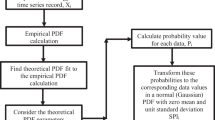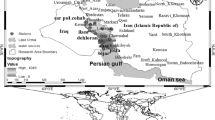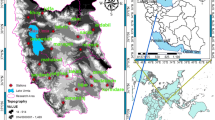Abstract
Drought as a natural hazard is characterized using quantitative measures named drought indices. Thus, accurate drought monitoring requires approaches for assessment of drought indices. This work investigates precision of an adaptive neuro-fuzzy computing technique (ANFIS) for drought index estimation through the obtained ANFIS-index. The input data was collected from six meteorological stations in Serbia during the period 1980–2010. Based on selected data, the drought indices such as the water surplus variability index (WSVI) and standardized precipitation index (SPI) for 12 month time scale were calculated. To approve the proposed approach, the ANFIS-index is statistically and graphically compared with SPI and WSVI values. The root-mean-square error ranged between 0.11 and 0.24. The ANFIS-index was highly correlated with SPI and WSVI. The results also show that ANFIS can be efficient applied for reliable drought indices estimation.





Similar content being viewed by others
Change history
29 May 2019
The Editor-in-Chief of Stochastic Environmental Research and Risk Assessment is issuing an editorial expression of concern to alert readers that this article (Goci�� et al. 2015) shows substantial indication of irregularities in authorship during the submission process.
29 May 2019
The Editor-in-Chief of Stochastic Environmental Research and Risk Assessment is issuing an editorial expression of concern to alert readers that this article (Goci�� et al. 2015) shows substantial indication of irregularities in authorship during the submission process.
References
Abarghouei HB, Kousari MR, Zarch MAA (2013) Prediction of drought in dry lands through feed forward artificial neural network abilities. Arab J Geosci 6:1417–1433
Allen RG, Pereira LS, Raes D, Smith M (1998) Crop evapotranspiration. Guidelines for computing crop water requirements. FAO Irrigation and Drainage Paper 56, Roma
Bacanli UG, Firat M, Dikbas F (2009) Adaptive neuro-fuzzy inference system for drought forecasting. Stoch Environ Res Risk Assess 23:1143–1154
Belayneh A, Adamowski J, Khalil B, Ozga-Zielinski B (2014) Long-term SPI drought forecasting in the Awash River Basin in Ethiopia using wavelet neural network and wavelet support vector regression models. J Hydrol 508:418–429
Birch EL (2014) A review of climate change 2014: impacts, adaptation, and vulnerability and climate change 2014: mitigation of climate change. J Am Plan Assoc 80(2):184–185
Byun H, Wilhite DA (1999) Objective quantification of drought severity and duration. J Clim 12:2747–2756
Dracup JA, Lee KS, Paulson EN Jr (1980) On the statistical characteristics of drought events. Water Resour Res 16(2):289–296
Gocic M, Trajkovic S (2013) Analysis of precipitation and drought data in Serbia over the period 1980–2010. J Hydrol 494:32–42
Gocic M, Trajkovic S (2014a) Spatiotemporal characteristics of drought in Serbia. J Hydrol 510:110–123
Gocic M, Trajkovic S (2014b) Drought characterisation based on water surplus variability index. Water Resour Manag 28(10):3179–3191
Gocic M, Trajkovic S (2014c) Water surplus variability index as an indicator of drought. J Hydrol Eng. doi:10.1061/(ASCE)HE.1943-5584.0001008
Hong X, Guo S, Zhou Y, Xiong L (2014) Uncertainties in assessing hydrological drought using streamflow drought index for the upper Yangtze River basin. Stoch Environ Res Risk Assess. doi:10.1007/s00477-014-0949-5
Hu Y-M, Liang Z-M, Liu Y-W, Wang J, Yao L, Ning Y (2014) Uncertainty analysis of SPI calculation and drought assessment based on the application of Bootstrap. Int J Climatol. doi:10.1002/joc.4091
Jang J-SR (1993) ANFIS: adaptive-network-based fuzzy inference systems. IEEE Trans Syst, Man, Cybern 23:665–685
Jang J-SR, Sun C-T, Mizutani E (1997) Neuro fuzzy and soft computing: a computational approach to learning and machine intelligence. Prentice-Hall, Upper Saddle River
Liu YW, Wang W, Hu YM, Liang ZM (2014) Drought assessment and uncertainty analysis for Dapoling basin. Nat Hazards 74(3):1613–1627
Masinde M (2013) Artificial neural networks models for predicting effective drought index: factoring effects of rainfall variability. Mitig Adapt Strateg Glob Chang. doi:10.1007/s11027-013-9464-0
McKee TB, Doesken NJ, Kleist J (1993) The relationship of drought frequency and duration to time scales. In: 8th Conference on applied climatology, 17–22 Jan, Anaheim, 179–184
McKee TB, Doesken NJ, Kleist J (1995) Drought monitoring with multiple time scales. In: 9th Conference on applied climatology, American Meteorological Society, Boston, 233–236
Mishra AK, Singh VP (2010) A review of drought concepts. J Hydrol 354(1–2):202–216
Mishra AK, Singh VP, Desai VR (2009) Drought characterization: a probabilistic approach. Stoch Environ Res Risk Assess 23(1):41–55
Morid S, Smakhtin V, Bagherzadeh K (2007) Drought forecasting using artificial neural networks and time series of drought indices. Int J Climatol 27:2103–2111
Özger M, Mishra AK, Singh VP (2011) Estimating palmer drought severity index using a wavelet fuzzy logic model based on meteorological variables. Int J Climatol 31:2021–2032
Özger M, Mishra AK, Singh VP (2012) Long lead time drought forecasting using a wavelet and fuzzy logic combination model. J Hydrometeorol 13:284–297
Palmer WC (1965) Meteorological drought, Research Paper No. 45, US Department of Commerce Weather Bureau, Washington
Pongracz R, Bogardi I, Duckstein L (1999) Application of fuzzy rule-based modeling technique to regional drought. J Hydrol 224(1999):100–114
Sugeno M, Kang GT (1998) Structure identification of fuzzy model. Fuzzy Sets Syst 28:15–33
Takagi T, Sugeno M (1983) Derivation of fuzzy control rules from human operator’s control actions. In: Proceedings of the IFAC symposium on fuzzy information, knowledge representation and decision analysis, 55–60
Takagi T, Sugeno M (1985) Fuzzy identification of systems and its applications to modeling and control. IEEE Trans Syst, Man, Cybern 15:116–132
Tate EL, Gustard A (2000) Drought definition: a hydrological perspective. In: Vogt JV, Somma F (eds) Drought and drought mitigation in Europe. Kluwer Academic Publishers, The Netherlands, pp 23–48
Tsakiris G, Pangalou D, Vangelis H (2007) Regional drought assessment based on the reconnaissance drought index (RDI). Water Resour Manag 21:821–833
Vicente-Serrano SM, Beguería S, López-Moreno JI (2010) A multi-scalar drought index sensitive to global warming: the standardized precipitation evapotranspiration index—SPEI. J Clim 23:1696–1718
Vicente-Serrano SM, Beguería S, Lorenzo-Lacruz J, Camarero JJ, López-Moreno JI, Azorin-Molina C, Revuelto J, Morán-Tejeda E, Arturo Sanchez-Lorenzo A (2012) Performance of drought indices for ecological, agricultural, and hydrological applications. Earth Interact 16(10):1–27
Wilhite DA, Glantz MH (1985) Understanding the drought phenomenon: the role of definitions. Water Int 10(3):111–120
Acknowledgments
The authors express their sincere thanks for the funding support they received from HIR-MOHE University of Malaya under Grant No. UM.C/HIR/MOHE/ENG/34. The study is also supported by the Ministry of Education, Science and Technological Development, Republic of Serbia (Grant No. TR37003).
Author information
Authors and Affiliations
Corresponding author
Rights and permissions
About this article
Cite this article
Gocić, M., Motamedi, S., Shamshirband, S. et al. Potential of adaptive neuro-fuzzy inference system for evaluation of drought indices. Stoch Environ Res Risk Assess 29, 1993–2002 (2015). https://doi.org/10.1007/s00477-015-1056-y
Published:
Issue Date:
DOI: https://doi.org/10.1007/s00477-015-1056-y




